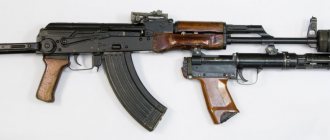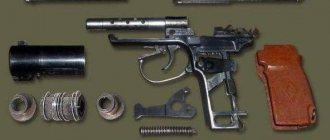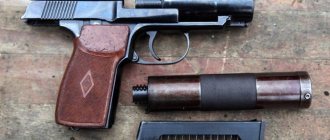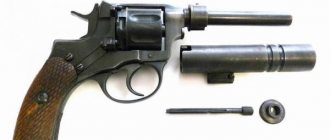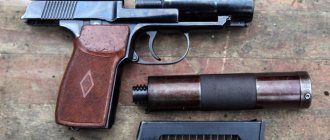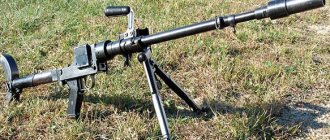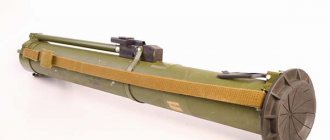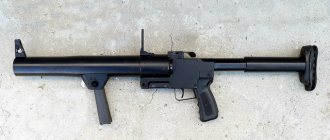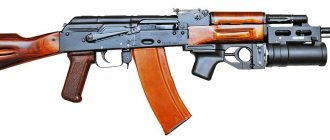Silent rifle-grenade launcher system (SGK) "Canary"
Some theoretical calculations of such a science as countering sabotage and terrorism state that the higher the organization of sabotage and terrorist groups, the more sophisticated the weapons used against them should be, and the retaliatory strikes should be more united and massive.
Until the 70s of the 20th century, until a network of anti-Soviet organizations of various kinds was created in the USSR (now it is fashionable to replace this term with the word “anti-constitutional”), the issue of creating high-precision SGCs for special purpose units was not so pressing. There were isolated cases of plane hijackings and prisoners escaping from under convoy, but this was not widespread. If the reader remembers, in the USSR banditry was over by 1960.
Therefore, until this time, the secret operations units of the USSR Ministry of Internal Affairs and the USSR KGB used in their tactics mainly small arms models adapted for the tactical actions of such special groups. An example of operational use is the SGK “Tishina” based on AKM and “Canary” based on AKS74U, which were previously in service with such units, as well as PB and APB pistols.
But this did not fully meet the requirements for the armament of such special forces. For example, the dimensions of the weapons used created inconvenience during the final phases of special operations to capture bandits and free hostages; the presence of grenade launchers in the machine gun set reduced the effective firing range and limited the resources of use. Therefore, the leadership of the KGB of the USSR and the GRU of the General Staff of the USSR received the task from the Politburo of the CPSU Central Committee to develop new systems, which was subsequently successfully carried out. Currently, the weapons of special units of the FSB of the Russian Federation and the Ministry of Internal Affairs of the Russian Federation are represented by modern types of special weapons that meet the assigned tasks of these groups to counter a potential enemy.
The art of organically interweaving the seemingly contradictory performance characteristics of a sniper rifle and an assault rifle only emphasizes the talent of Russian gunsmiths who were able to solve this difficult problem.
One of the prototypes of modern SGKs was the silent rifle-grenade launcher complex (SGK) "Canary", which had the following tactical and technical data:
AKSB 74U (silent AKS - 74U) with a BS-1 grenade launcher Barrel caliber 5.45/30 mm Shot - 5.45×39 Weight without weapons set - 5.43 kg Length with butt for shooting with a rest - 900 mm Firing range ( sighting) - 400 m (both with a bullet and a grenade) Grenade flight speed - 105 m/s Machine clip - 20 or 30 shots, grenade launcher - 8 special shots.
Set
The kit of the silent rifle-grenade launcher complex (SGK) "Canary" includes
AKSB 74U assault rifle with PBS-4 device, special US74U cartridge, BS-1 grenade launcher with shot, throwing cartridge and magazine clip
This oversized SGK, which is structurally designed on the AKS 74U platform, combines not only two types of shots (grenade and small arms cartridge), but also two main indicators of reducing the sound characteristics of a shot - the spread of gunpowder gases and their localization.
The assault rifle with a shortened barrel (modification AKSB 74U) is adapted for the use of a 30-mm silent grenade launcher BS-1, which was used in the Tishina SGK complete with an AKM assault rifle with PBS-1, where it showed good test results.
The grenade is inserted into a grenade launcher barrel, which operates on the principle of localizing powder gases from the muzzle of the barrel. The flight of the grenade is carried out by pushing it out with a piston under the action of a propellant cartridge created on the basis of the 7.62x53R cartridge. A clip for 8 such ammunition is designed in the handle of the grenade launcher; the cartridges are fed manually and sent using a bolt moving in the longitudinal direction. The standard SGK "Canary" grenade has a cumulative effect, providing penetration of 1.5 cm of steel sheet with subsequent spraying of hot gases, creating the so-called. "cumulative effect". The grenade launcher weighs 1.7 kg. The assembly sighting frame of the product is structurally fixed to the bracket of the mechanical sighting device of the machine gun, which uses a US bullet for firing with an initial speed not exceeding the sound threshold. To reduce recoil when firing, the butt plate of the buttstock is equipped with a rubber shock absorber.
The silent and flameless firing device PBS-4, which is lightweight, is mounted on a bracket on the barrel of the machine gun. Without a seal made of rubber materials, shooting is carried out with both standard cartridges and US ammunition.
"Silence" and "Canary"
To solve a number of special problems, the effectiveness of special small arms that provide silent and flameless shooting turns out to be insufficient. Tasks such as damaging enemy command posts, destroying missiles on the move and at launch positions, helicopters and airplanes on the ground, disrupting important command and control links, and others, including sabotage, require the use of more powerful weapons that combine the same special properties with greater destructive action.
In the 1970s, the special silent rifle-grenade launcher system “Silence” entered service with special units of the Soviet Army. The complex included a special silent modification of the 7.62-mm Kalashnikov assault rifle with a folding shoulder rest AKMSB with a silent and flameless firing device PBS-1 and a special 30-mm silent under-barrel grenade launcher.
| rifle-grenade launcher system "Silence" AKMS assault rifle, PBS-1 silencer, BS-1 under-barrel grenade launcher (RGA-86) |
The PBS-1 silent firing device is screwed onto the threaded seat of the muzzle of the machine gun barrel instead of a compensator. The device is a cylindrical chamber divided into compartments by steel washers. The washers are fastened with three steel rods. There are holes in the center of the washers for the free passage of bullets. In front of the first compartment from the muzzle of the machine gun barrel there is a solid rubber washer 18-20 mm thick, which initially (newly installed) had no holes. In front of the washer there is an additional chamber for the transfer of powder gases with four holes around the circumference, opening into an expansion chamber at the base of the PBS, which also has four holes around the circumference of the body.
When the bullet passes the muzzle of the barrel, the powder gases rushing behind it enter the transfer chamber and some of the gases are redirected through the holes in the chamber into the expansion chamber, where, having lost pressure and temperature, they are released into the atmosphere through the external holes. Thus, in general, the pressure and temperature of the powder gases drop. Continuing its movement, the bullet pierces the rubber washer; the edges of the washer's hole, due to the elasticity of the rubber, close and create an obstacle to the passage of gases that expand after the bullet. Passing through the hole in the washer, the gases again lose speed. Having passed the hole in the washer, the powder gases enter the expansion chamber. Due to the volume of the chamber and the presence of separating washers, the pressure of the gases decreases, their temperature drops, and the gases are broken up into mutually inhibiting flows.
This ensures the absence of a muzzle flame when fired - flamelessness - and reduces the sound of the shot to a level of 130 - 135 dB, typical for weapons with a silencer. The hole of the washer gradually increases, so the washer is a replaceable element of PBS-1. PBS-1 weight - 640 g, length - 196 mm, largest diameter - 53 mm.
Firing from a machine gun with PBS-1 is carried out only with special US (reduced velocity) cartridges with a subsonic initial speed of a weighted bullet. The bullet tip of the cartridges is painted black with a green border.
under-barrel grenade launcher BS-1 (RGA-86)
The most interesting component of the complex can be considered a 30-mm under-barrel silent grenade launcher.
The BS-1 Silence silent grenade launcher system was developed in the mid-1960s at the Central Research Institute of Precision Engineering for arming special forces units of the Soviet Army. The complex, which was an under-barrel grenade launcher for the AKMS assault rifle and grenades for the grenade launcher that was in service with special forces, was based on previously developed independent samples of silent weapons, in particular, a single-shot 30-mm silent grenade launcher “product D”. To ensure silent and flameless throwing of a grenade, the “product” used special “Phalanx” expelling cartridges with cut-off of powder gases inside the cartridge case (similar in design to 7.62mm PZ “Snake” cartridges, but of a larger caliber and size), and the starting impulse was transmitted to the grenade using rod attached to the back of its body. This design was very complex, primarily due to the high complexity and high cost of special cartridges, and therefore in the BS-1 “Silence” complex it was decided to abandon the cutoff of gases inside each cartridge case, and instead lock the powder gases in the barrel of the weapon, which would allow the use of much simpler and cheaper blank cartridges of conventional design for throwing grenades.
The grenade launcher is attached to the lower part of the forend and barrel of the machine gun, which has corresponding attachment points. Thus, unlike the 40-mm GP-25 “Koster” (GP-30 “Obuvka”) under-barrel grenade launcher, the silent grenade launcher cannot be attached to any standard machine gun. The grenade launcher's ammunition is a 30-mm cumulative grenade. Due to the design of the weapon, the grenade does not have a propellant charge. To throw a grenade, the energy of the powder gases of a special propelling cartridge is used.
The throwing cartridge is based on the cartridge case of a standard 7.62x39 machine gun cartridge. Unlike standard blank machine gun cartridges, the propellant cartridge case is not extended. The case muzzle is compressed with an asterisk, as in conventional blank cartridges. The throwing cartridges are loaded into a special magazine, which is placed in the pistol grip of the grenade launcher.
The grenade launcher is equipped with a rifle-type sliding bolt, which reloads the grenade launcher with propelling cartridges from the breech of the weapon and locks the barrel. In this case, the grenade launcher is muzzle-loading, because The grenade is inserted into the barrel of the grenade launcher from the muzzle side. The grenade is held in the barrel by spring bends in the walls of the barrel. In flight, the grenade is stabilized by rotation - on the body of the grenade there are ready-made protrusions that fit into the rifling of the barrel when loading the grenade - just like in the GP-25 (GP-30) grenade launcher. But in this case there are not 12 grooves, but 3.
When a throwing cartridge is fired, powder gases do not act directly on the bottom of the grenade, but on a special piston, which pushes the grenade out of the barrel and locks (cuts off) the powder gases in the chamber, which ensures a silent and flameless shot. The initial speed of the grenade is 100 m/s.
It must be said that the very principle of eliminating the sound and flash of a shot by locking powder gases in a closed volume is quite old - the first patents for such systems date back to the beginning of the twentieth century. It should also be noted that around the same period (1960-70s), a whole series of small-caliber (50-60 mm) mortars were developed in the West to arm their special forces, using the same principle of muffling the sound of a shot. Be that as it may, the BS-1 “Silence” complex entered service with the army special forces of the USSR Armed Forces. Its purpose was to destroy targets such as fuel containers, parked aircraft, cabins with electronic equipment, operational-tactical missile launchers, etc. Obviously, the noiselessness and flamelessness of the shot significantly reduced the chances of quickly detecting the shooter, and therefore increased the chances of the special forces successfully completing a combat mission and even, possibly, a successful retreat after completing the task.
With the transition in the mid-1970s. to a new caliber and the adoption of a small arms complex chambered for the 5.45x39 cartridge into service by the Soviet Army, the need arose for a corresponding modernization of the silent rifle-grenade launcher complex. However, it was not possible to successfully solve this problem on the basis of the AK-74 (AKS-74) assault rifle. With a small caliber, the relative length of the machine gun barrel, with the same dimensions of the weapon, has become significantly larger. And the bullets of the US (reduced velocity) cartridges, used for silent shooting, gave unstable ballistics. Therefore, further work was continued with a shortened modification of the 5.45 mm assault rifle - AKS-74U.
| 6S1 “Canary” rifle-grenade launcher system, AKS-74UB assault rifle, PBS-4 silencer, BS-1M under-barrel grenade launcher (grenade launcher sight in firing position) |
The new special rifle-grenade launcher complex received the somewhat strange name “Canary” (index - 6S1). The concept of the complex remained unchanged. The grenade launcher has undergone minor modifications. The main one is the transition to throwing cartridges made on the basis of the cartridge case of a standard 5.45-mm machine gun cartridge. Externally, the grenade launcher is practically indistinguishable from the previous modification.
A special modification of the shortened AKS-74U assault rifle - AKS-74UB - is equipped with grenade launcher attachment points. More modern models of PBS silent firing devices are used with the machine gun. The PBS-4 modification does not have a rubber washer and, along with “US” cartridges, can also be fired with conventional cartridges.
To reduce the size of the complex, a shortened magazine with a capacity of 20 rounds was developed for the machine gun, which can be used along with standard 30 and 45 round magazines.
| rifle-grenade launcher complex 6S1 "Canary" automatic rifle AKS-74UB, muffler PBS-4, under-barrel grenade launcher BS-1M (The leather cover on the forend of the assault rifle serves to cover the bracket for installing the grenade launcher on the forend when the grenade launcher is removed from the weapon. The assault rifle is equipped with a rare magazine for 20 cartridges. Grenade launcher sight in stowed position.) |
To soften the recoil when firing a grenade, a rubber shock absorber of the same type as is used for machine guns with GP-25 (GP-30) is put on the butt plate of the butt.
BS-1M under-barrel grenade launcher
While maintaining the general design of the grenade launcher and grenade and their general appearance, the designers of the Central Research Institute TOCHMASH managed to increase both the effectiveness of the grenade warhead and the firing range of the grenade launcher, while instead of a blank cartridge of 7.62x39mm caliber, special blank cartridges of 5.45x39 caliber began to be used . Around the beginning of the eighties of the twentieth century, the silent 30-mm grenade launcher system 6S1 “Canary”, consisting of a BS-1M grenade launcher, an AKS-74UB assault rifle and a PBS-4 silencer, began to arrive in special forces units of the Soviet Army.
The BS-1 (RGA-86) silent under-barrel grenade launcher is a separate-loading weapon, in which the fired grenade is loaded into the barrel from the muzzle, and expelling (propelling) charges are fed into the breech of the barrel. At the moment of firing, powder gases from a blank cartridge push forward a piston located at the rear of the barrel, accelerating the piston and grenade to a speed of over 100 m/s (up to 175 m/s for BS-1M). After the grenade leaves the barrel, the piston stops in the barrel, locking the high-pressure powder gases in a closed volume. After they cool down and the pressure drops to a safe level, the grenade launcher can be reloaded, i.e. loading a new grenade into the barrel (in this case the piston settles back), ejecting the spent cartridge case and chambering a new expelling cartridge. The weapon is reloaded with cartridges from a detachable box magazine (capacity of 8 cartridges for BS-1 or 10 for BS-1M), located in the handle of the grenade launcher, using a longitudinally sliding rifle-type rotary bolt. For firing, the grenade launcher has a trigger and a manual safety catch. Two types of grenades are used: combat armor-piercing incendiary grenades (designation VOG-T) and training grenades with an inert warhead. In both cases, the stabilization of the grenade in flight is carried out by its rotation, for which purpose the grenade body has ready-made protrusions for following the rifling in the grenade launcher barrel.
| silent grenade launcher BS-1M of the "Canary" complex grenade launcher, 30mm grenade, expelling cartridge, magazine for expelling cartridges |
To install a grenade launcher on an assault rifle, special mounts are used, while the early version (for AKMS) and the later version (for AKS-74UB) have different bracket systems and are incompatible in terms of seats.
The sighting device of the grenade launcher in “Silence” is a folding frame bar, and in “Canary” it is a folding rack, having a rear sight that is combined with the standard front sight of the machine gun when firing. The bar (and in the “Canary” - the stand) is fixed on the block of the machine gun sight and is equipped with a mechanism for introducing corrections. The aiming bar of the machine gun is also additionally equipped with a clamp for firing cartridges with US bullets, the trajectory of which differs from conventional ones.
The maximum sighting range of fire from the grenade launcher of the “Silence” complex is 300 m. The cumulative grenade provides penetration of 10 mm thick armor and the necessary blocking effect on the target. For the Canary, these characteristics are increased and amount to 400 m and 15 mm, respectively. The maximum sighting range of fire from 7.62 mm and 5.45 mm machine guns with US cartridges is 400 meters.
The mass of an unloaded grenade launcher is 2 kg. The weight of the 7.62-mm AKMSB assault rifle with PBS-1 and a 30-mm silent grenade launcher, without a grenade and cartridges, is approx. 6 kg. The weight of the 5.45-mm AKS-74UB assault rifle with PBS-4 and 30-mm silent grenade launcher BS-1, without a grenade and cartridges is 5.43 kg, length with the butt folded down is 900 mm.
Russian special purpose weapons
This compact complex, made on the basis of a shortened AKSB 74U assault rifle, and which entered service with special forces units of the Soviet Army in the early 1980s, combines not only two types of projectiles (a bullet and a grenade), but also two basic principles for reducing the sound level of a shot — expansion of powder gases and their cutoff in the chamber.
Earlier, in the 1970s, the special silent rifle-grenade launcher system “Silence” entered service with special forces units of the Soviet Army, which included a “silent” modification of the 7.62-mm Kalashnikov AKMS assault rifle (with the PBS-1 silent and flameless firing device) and special 30-mm silent under-barrel grenade launcher. But with the adoption of a new small arms system chambered for the 5.45 mm low-pulse automatic cartridge into service in the mid-1970s, the need arose for a corresponding modernization of the silent small arms and grenade launcher system. The complex retained the same concept, and was based on a shortened 5.45-mm AKSB 74U assault rifle and a 30-mm silent grenade launcher BS-1 (BS-1M).
The special rifle-grenade launcher complex was named “Canary” (index 6S1). The assault rifle is a modification of the AKSB 74U (index 6P27), modified to mount a 30-mm grenade launcher. The silent and flameless firing device PBS-4 is attached to the muzzle of the machine gun barrel.
The main purpose of the grenade launcher was initially to destroy targets such as fuel tanks, parked aircraft, cabins with electronic equipment, operational-tactical missile launchers, etc.
The grenade launcher, operating according to the gas cut-off scheme, is adjacent to the lower part of the forend and barrel of the machine gun, which has the corresponding attachment points. That is, unlike the “regular” under-barrel grenade launchers GP-25 and GP-30, the silent grenade launcher cannot be attached to any standard machine gun. The grenade launcher's ammunition is a 30-mm grenade, the cumulative warhead of which pierces a steel sheet about 10 mm thick. Due to the peculiarities of the weapon design (a shot with cut-off of powder gases), the grenade does not have its own propellant charge. The grenade is inserted into the barrel of the grenade launcher from the muzzle and pushed out by a piston driven by a special blank cartridge for throwing, loaded from the breech (so the grenade launcher has separate loading, both from the muzzle and from the breech). The loaded grenade is held by spring bends in the walls of the barrel. In flight, the grenade is stabilized by rotation - on the body of the grenade there are three ready-made protrusions that fit into 3 screw rifling of the barrel bore when loading.
The throwing cartridges are loaded into a magazine, which is located in the pistol grip of the grenade launcher, and are fed into the chamber from the breech using a rifle-type sliding bolt. The grenade launcher has a firing mechanism with a trigger and a non-automatic safety catch.
Components and ammunition of the Canaryka rifle-grenade launcher complex: 1 - PBS-4; 2 — cartridge 5.45×39 (7U1); 3 — automatic rifle AKSB 74U with magazine; 4 — BS-1 grenade launcher; 5 — grenade for the B01 grenade launcher; 6 - let's throw a cartridge; 7 — magazine with cartridges for throwing
The throwing cartridge, unlike standard blank machine gun cartridges, does not have an elongated cartridge case. The case muzzle is compressed with an asterisk, as in conventional blank cartridges. When fired, the powder gases of the throwing cartridge act on the piston, the piston pushes the grenade out of the barrel and locks (cuts off) the powder gases in the chamber, which ensures a silent and flameless shot.
The aimed grenade firing range of the "Canary" complex has increased compared to the "Silence" complex - up to 400 m. The folding rack-mount sight of the grenade launcher is attached to the base of the machine gun sight and has a rear sight, which is combined with the machine's standard front sight when aiming. The machine gun's sight itself is designed to fire a US bullet at a subsonic initial speed. To soften the recoil of the grenade launcher, a shock absorber is placed on the butt plate of the butt.
Tactical and technical characteristics of AKSB-74U with BS-1 grenade launcher
Caliber: 5.45/30 mm Cartridge: 5.45 x 39 Weight without cartridges and without grenades: 5.43 kg Length with folded butt: 900 mm Sighting range: 400 m (bullet), 400 m (grenade) Initial speed grenades: 105 m/s Automatic magazine capacity: 20 or 30 rounds Grenade launcher magazine capacity: 8 special rounds
« back | menu | forward "
LiveInternetLiveInternet
In the 1970s, the special silent rifle-grenade launcher system “Silence” entered service with special units of the Soviet army to solve such problems as damaging enemy command posts, destroying missiles on the move and at launch positions, helicopters and airplanes on the ground, and disrupting important links management and others, including sabotage.
| rifle and grenade launcher system "Silence": AKMS assault rifle, PBS-1 silencer, BS-1 under-barrel grenade launcher (RGA-86) |
The complex included a special silent modification of the 7.62-mm Kalashnikov assault rifle with a folding shoulder rest AKMSB with a silent and flameless firing device PBS-1 and a special 30-mm silent under-barrel grenade launcher.
BS-1 (RGA-86) under-barrel grenade launcher
The most interesting component of the complex can be considered the BS-1 (RGA-86) 30-mm under-barrel silent grenade launcher.
The grenade launcher is attached to the lower part of the forend and barrel of the machine gun, which has corresponding attachment points. Thus, unlike the 40-mm GP-25 “Koster” (GP-30 “Obuvka”) under-barrel grenade launcher, the silent grenade launcher cannot be attached to any standard machine gun. The grenade launcher's ammunition is a 30-mm cumulative grenade. Due to the design of the weapon, the grenade does not have a propellant charge. To throw a grenade, the energy of the powder gases of a special propelling cartridge is used.
The throwing cartridge is based on the cartridge case of a standard 7.62x39 machine gun cartridge. Unlike standard blank machine gun cartridges, the propellant cartridge case is not extended. The case muzzle is compressed with an asterisk, as in conventional blank cartridges. The throwing cartridges are loaded into a special magazine, which is placed in the pistol grip of the grenade launcher.
| BS-1 | BS-1M | |
| Caliber, mm | 30 | |
| Weight, kg | 2.0 | 2.0 |
| Magazine capacity, no. cartridges | 8 | 10 |
| Initial speed of the grenade, m/s | 100 | 175 |
| Effective firing range, m | 100 — 150 | |
| Maximum aimed firing range, m | 300 | 400 |
| Armor penetration, mm | 10 | 15 |
The grenade launcher is equipped with a rifle-type sliding bolt, which reloads the grenade launcher with propelling cartridges from the breech of the weapon and locks the barrel. In this case, the grenade launcher is muzzle-loading, because The grenade is inserted into the barrel of the grenade launcher from the muzzle side. The grenade is held in the barrel by spring bends in the walls of the barrel. In flight, the grenade is stabilized by rotation - on the body of the grenade there are ready-made protrusions that fit into the rifling of the barrel when loading the grenade - just like in the GP-25 (GP-30) grenade launcher. But in this case there are not 12 grooves, but 3.
When a throwing cartridge is fired, powder gases do not act directly on the bottom of the grenade, but on a special piston, which pushes the grenade out of the barrel and locks (cuts off) the powder gases in the chamber, which ensures a silent and flameless shot. The initial speed of the grenade is 100 m/s.
With the transition in the mid-1970s. to a new caliber and the adoption of a small arms complex chambered for the 5.45x39 cartridge into service with the SA, a need arose for a corresponding modernization of the silent small arms and grenade launcher complex. However, it was not possible to successfully solve this problem on the basis of the AK-74 (AKS-74) assault rifle. Therefore, further work was continued with a shortened modification of the 5.45 mm assault rifle - AKS-74U.
| 6S1 “Canary” rifle and grenade launcher system: AKS-74UB assault rifle, PBS-4 silencer, BS-1M under-barrel grenade launcher (grenade launcher sight in firing position) |
The new special rifle-grenade launcher complex was called “Canary” (index - 6S1). The concept of the complex remained unchanged. The grenade launcher has undergone minor modifications. The main one is the transition to throwing cartridges made on the basis of the cartridge case of a standard 5.45-mm machine gun cartridge. Externally, the grenade launcher is practically indistinguishable from the previous modification. A special modification of the shortened AKS-74U assault rifle - AKS-74UB - is equipped with grenade launcher attachment points. While maintaining the general design of the grenade launcher and grenade and their general appearance, the designers managed to increase both the effectiveness of the grenade warhead and the firing range of the grenade launcher.
BS-1M under-barrel grenade launcher
Around the beginning of the eighties of the twentieth century, the silent 30-mm rifle-grenade launcher system 6S1 “Canary”, consisting of a BS-1M grenade launcher, an AKS-74UB assault rifle and a PBS-4 silencer, began to arrive in special forces units of the Soviet Army.
To soften the recoil when firing a grenade, a rubber shock absorber of the same type as is used for machine guns with GP-25 (GP-30) is put on the butt plate of the butt.
The sighting device of the grenade launcher in “Silence” is a folding frame bar, and in “Canary” it is a folding rack, having a rear sight that is combined with the standard front sight of the machine gun when firing. The bar (and in the “Canary” - the stand) is fixed on the block of the machine gun sight and is equipped with a mechanism for introducing corrections.
main components of the Canaryka rifle-grenade launcher complex
The grenade launcher is reloaded with cartridges from a detachable box magazine (capacity of 8 rounds for BS-1 or 10 for BS-1M), located in the handle of the grenade launcher, using a longitudinally sliding rifle-type rotary bolt.
For firing, the grenade launcher has a trigger and a manual safety catch.
Two types of grenades are used for firing: combat armor-piercing incendiary grenades (VOG-T) and training grenades with an inert warhead.
The maximum sighting range of fire from the grenade launcher of the “Silence” complex is 300 m. The cumulative grenade provides penetration of 10 mm thick armor and the necessary blocking effect on the target. For the Canary, these characteristics are increased and amount to 400 m and 15 mm, respectively.
